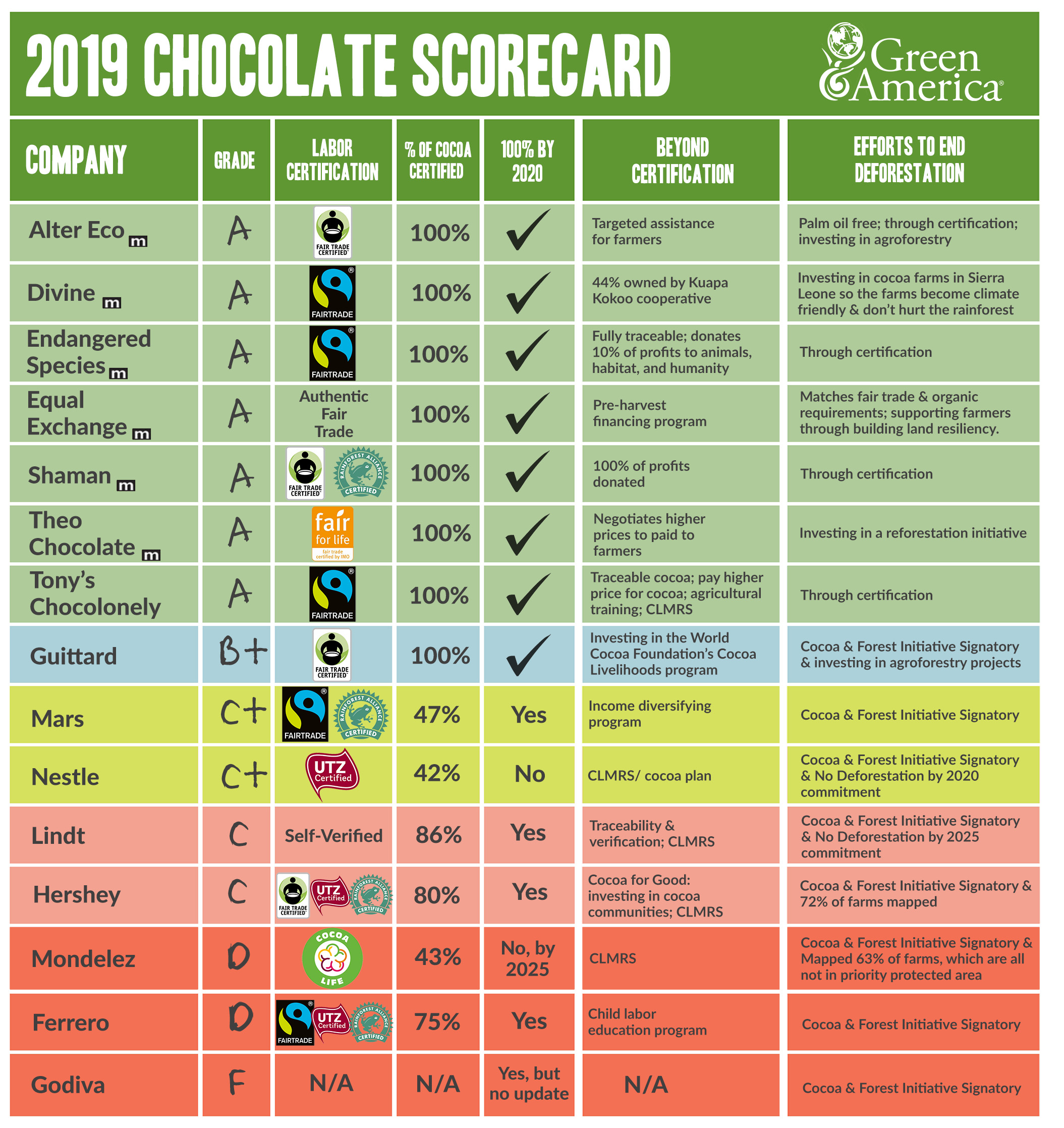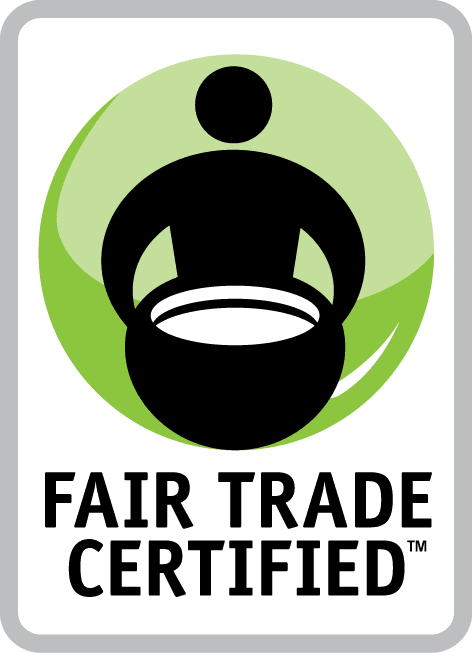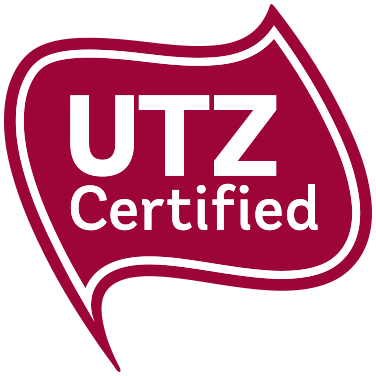|
Child Labor in Your Chocolate? Check Our Chocolate Scorecard |
According to the US Department of Labor, more than 2 million children in Ghana and Cote d’Ivoire work in hazardous conditions growing cocoa, the main ingredient in chocolate 1. While some companies have begun tracing their supply chains to prevent child labor, the vast majority of the 3 million tons of cocoa produced each year come from small farms in West Africa, where farmers and their children live on less than $1 per day2.
A Chocolate Scorecard on Sustainability
This scorecard will help you find ethically sourced sweets and understand what the certification labels on cocoa actually mean. This is, of course, not a comprehensive list of ethically sourced chocolate companies; however, the scorecard features companies who are also Green Business Network members, as Green America has screened them for their environmental, social justice, and human rights practices. Chocolate bars with an "A" rating are addressing farmer income and child labor issues, and are organic and/or non-GMO certified.
Most major chocolate companies have commitments to source more sustainable cocoa. In fact, many of them have plans to have 100% certified cocoa in their supply chain by 2020. Although this is an important step in the right direction, certification programs alone are not enough to solve the underlying issues that contribute to child labor in cocoa, including farmer poverty and a lack of infrastructure.
With that in mind, last year we expanded our chocolate scorecard to go beyond commitments about certified chocolate to look at programs that support farmers and address child labor when it is found. Additionally, while the scorecard’s ratings are still heavily based on efforts to combat child labor, this year we’ve added a new category on deforestation. On top of a child labor problem, the cocoa industry has a huge negative impact on forests. In the Ivory Coast and Ghana, 90% of their forests have been lost and the cocoa industry is a big driver of that deforestation. Much of that deforestation was caused by the largest cocoa companies, and, as a result of activist pressure, they worked with the World Cocoa Foundation to create the Cocoa and Forest Initiative to prevent further damage.
A Chocolate Scorecard on Child Labor and Deforestation
With this updated scorecard, we are not only looking at how much certified cocoa a major chocolate company has, we are also looking to see if the company has innovative programs and projects in place to address some of the other underlying issues of child labor in cocoa and if the company is working to address deforestation. Although companies may have programs going beyond certification that sound similar, they can vary in practice in regards to how comprehensive and impactful they are, and the final grade reflects that.
Such programs include:
- Child Labor Monitoring and Remediation Systems, which work with communities and families to address why child labor is happening on farms;
- Farmer income generating programs;
- Traceability mechanisms for fuller supply chain transparency.
You can learn more about what went into the different grades here.

Click to here to download your own copy of Green America's Chocolate Scorecard
 denotes members of Green America's Green Business Network. denotes members of Green America's Green Business Network. 
Equal Exchange (EE) was founded to challenge the existing trade model, which often does not favor small scale farmers. EE’s chocolate at a minimum meets fair trade standards but is no longer actively certified, as EE found certifiers to be tailored to the needs of big corporations and through the expansion of certifiers, some of the original values of the fair trade movement were weakened. Equal Exchange aims to create market access for small scale farmers, which at times was at odds with large certifiers. All EE chocolate suppliers are regularly audited against fair trade standards, and all EE products are fully traceable. On average EE pays more for cocoa than even the fair trade premium requires.
Godiva has committed to "100% sustainable cocoa by 2020," but has not provided information about who is certifying its cocoa, nor shared any progress or plans regarding their commitment.
All figures come from publicly available company information and the Cocoa Barometer. This list is not exhaustive of all chocolate companies. If your favorite chocolate brand is not listed, consider calling the company to ask about its commitment to ethical sourcing.
What The Certification Labels Mean
|
Label
|
About
|
|
Fairtrade

|
Fairtrade standards prohibit forced labor, child labor, and discrimination. If child labor is detected in a supply chain, Fairtrade immediately enacts its child protection policy and implements remediation efforts. Certified farmers’ organizations receive at least the Fairtrade Minimum Price for their cocoa beans and a Fairtrade Premium that they use to invest in their communities and business. To use the FAIRTRADE certification mark on a product, all ingredients that can be certified must come from Fairtrade sources.
|
|
Fair Trade Certified

|
Fair Trade USA’s Fair Trade Certified standards prohibit forced labor, child labor, and discrimination, and protects freedom of association and collective bargaining rights. If child labor should surface, remediation guidelines are in place. Certified farmers are guaranteed a fair trade floor price for their cocoa beans as well as a social premium. Fair Trade Certified certifies farmer cooperatives as well as larger plantations. Only cocoa needs to be certified for the chocolate bar to receive the seal.
|
IMO Fair For Life
 |
The IMO Fair for Life guarantees that smallholder farmers receive fair payment and that workers enjoy good and fair working conditions. The Fair for Life system prevents forced and child labor and also includes detailed environmental criteria. Fair For Life certified products must use Fair Trade ingredients if available, and regardless, 50% of all ingredients must be Fair Trade in order for a product to bear the seal. |
|
Rainforest Alliance (RA)

|
RA standards prohibit the use of forced labor, child labor, and discrimination, and farmers have the right to oragnize. RA does not require buyers to pay a specific minimum floor price for cocoa beans. RA reasons that by producing higher quality and sustainable cocoa beans, farmers should be able to earn a higher price for their beans over time.
|
|
UTZ

|
UTZ certification prohibits forced labor, child labor, and discrimination and protects the right to organize and bargain collectively. In terms of pricing, UTZ states that premiums are paid to farmers for their certified products, but the price is solely based on negotiations between the buyers and farmers. Paying the legal minimum wage is required.
|
NOTE: In 2018, Rainforest Alliance and Utz merged. In 2019, Rainforest Alliance will release its new standards. Until then, Rainforest Alliance and Utz standards will continue to be applied.
Updated October 16, 2019
1. DOL/Tulane University’s 2013/14 Survey Research on Child Labor in the West African Cocoa Sector
2. 2018 Cocoa Barometer
Back to the Vote With Your Dollar Toolkit |
|
DanoneWave and Green America to Advance Soil Health |
DanoneWave to Advance Soil Health
Green America’s Center for Sustainability Solutions has been collaborating with DanoneWave (maker of dairy and plant-based products, coffee creamers, and beverages) to implement sustainable agriculture practices in its supply chain. DanoneWave has announced the launch of a soil health initiative which will help dairies and growers implement practices that improve soil health. DanoneWave is committing up to $6M for research on soil regeneration and enhancement of organic matter and soil fertility over the next five years. See their press release below.
In addition, DanoneWave has joined with Green America, The Carbon Underground and others to develop a global verification standard for food grown in a regenerative manner. The standard seeks to encourage farmers to restore the carbon cycle and build soil health, crop resilience, and nutrient density.
DanoneWave Puts a Stake in the Ground with Commitment to Regenerative Agriculture and Soil Health Research Collaboration with Renowned Research Partners
Brings together a ‘dream team’ of expertise in the study of soil health, applicable to all agricultural systems in The Dannon Pledge portfolio of brands
- Begins with research that will spur transformation to support best-in-class soil health programs with experts and academics to benefit our farms and communities
- Builds on the company’s commitment to sustainable agriculture as articulated in The Dannon Pledge
- Reinforces company commitment to sustainable agriculture, joining The Carbon Underground to inform the design and development of a new global certification standard for food grown in a regenerative way and exploring options to participate in the Regenerative Organic Alliance
White Plains, NY (March 7, 2018) – Today, DanoneWave puts a stake in the ground, launching a ground-breaking soil health initiative with renowned experts and academics to build best-in-class soil health programs to benefit our farms and communities. The company shared an ambition to commit up to $6M for the research program over the next five years. This program will begin with products involved in The Dannon Pledge, and may have impact in the future across the DanoneWave portfolio. The Dannon Pledge is the company’s commitment to a range of progressive practices focused on sustainable agriculture, transparency and naturality, and enables the company to offer consumers more yogurt choices. The flagship brands that are leading with Non-GMO Project verification as part of The Dannon Pledge include Dannon®, Oikos® and Danimals®. Dannon is part of DanoneWave. To learn more about The Dannon Pledge, visit ExpoWest Booth 513 or dannonpledge.com.
“Soil is the foundation of our food system, with an estimated 95 percent[i] of food directly or indirectly reliant on soil.” said Ryan Sirolli, Agriculture Director, DanoneWave. “As America’s largest yogurt maker, we saw an opportunity to initiate this breakthrough research program with our supply chain. When we announced our Pledge, we committed to championing sustainable agriculture, which includes reaching for better soil health. We will evaluate soil on the farms of growers who provide feed for cows and on the dairy farms where we buy milk. The long-lasting relationships we have with our growers and dairy farmers, who have a passion for change and strive for continuous improvement, have empowered us to launch this program. We know this work requires collaboration to make a meaningful impact, and we are excited to bring together uniquely skilled partners to help us to continue to fulfill our ambition.”
DanoneWave will be advancing its soil health research program over the next 18 months. The aim of the soil health initiative is to identify ways to help regenerate soils, looking at enhancing organic matter and soil fertility with long-term benefits such as soil carbon sequestration, reduced chemicals use, soil water holding capacity, biodiversity and economic resilience of farmer communities. Key activities with participating grower and dairy farmer partners and third-party soil health experts will include soil sampling, review of yield, grower engagement, data collection and analysis, first reports and field days with farmers to provide training around soil health best practices.
“A priority on my farm is stewardship of the land. When we steward the soil well, we have better yields and we help mother nature. I am looking forward to working with DanoneWave to continue to improve soil health, and I am excited to look at the outcomes of this research program to consider how it impacts my farm and our practices,” said Rick Clark, a grower of Non-GMO Project Verified feed for the supply chain that supports brands involved in The Dannon Pledge at Clark Land and Cattle in Williamsport, Indiana.
The partners DanoneWave is announcing today are:
- Dr. Rattan Lal and the Carbon Management and Sequestration Center at The Ohio State University will lead soil sampling across a set of grower and dairy farmer partners. The team will analyze the samples and provide data for analysis. The team will then look at the data to identify practices to help increase the carbon intake of soil.
- Dr. Harold van Es and the soil health team at Cornell University will partner on soil health analysis for the program. The team will use results to make recommendations to be implemented over the next five years with an aim to improve soil health with participating grower and dairy farmer partners.
- EcoPractices, working with EFC/Ag Solver as a service provider, will gather information from program partners to analyze and share reports that help to create an understanding of what the data means for many stakeholders – importantly, our farmer partners.
In addition to announcing partners for the soil health initiative, today DanoneWave is also proud to join The Carbon Underground, Green America and other food companies to inform the design and development of a new global certification standard for food grown in a regenerative way. The soil health initiative and the company’s work to support The Carbon Underground are two important next steps in DanoneWave’s overarching regenerative ambition. To learn more about The Carbon Underground, read the latest press release here.
“With all life beginning and ending in soil, there is urgency to promote agricultural practices that can help regenerate soils. As a soil scientist who has conducted research in this area for the last 50 years, I am privileged to work with DanoneWave, a company that is setting an example for the private sector with a commitment to become carbon neutral,” said Dr. Rattan Lal, The Ohio State University. “The support of the private sector will ensure we can make changes on a significant scale. I hope that others will be inspired by this work and consider options for becoming involved.”
“Working with the private sector to tackle the question of how to improve soil health will help us make an impact at large scale,” said Dr. Harold van Es, Cornell University. “I’ve spent my career exploring opportunities to improve soil health, and I look forward to working with DanoneWave and the soil health program research team to implement changes based on what we learn through the research.”
Finally, the company is exploring options to participate in the Regenerative Organic Alliance, a group working to develop a new standard, which will be known as Regenerative Organic Certification. The work with the Regenerative Organic Alliance would be complementary to the company’s continued commitment to the USDA Organic Standard through pioneering brands. DanoneWave seeks to understand how this proposed certification can benefit our planet and farming communities through soil health, animal welfare, social fairness, and offer more choices for our consumers and our business.
About DanoneWave
Headquartered in White Plains, New York, and Broomfield, Colorado, the mission of DanoneWave is to bring health through food to as many people as possible via its diverse offering of dairy and plant-based foods in high growth and evolving categories. The ambition of DanoneWave is to produce healthful foods that create economic and social value and nurture natural ecosystems through sustainable agriculture. Every time we eat and drink, we vote for the world we want. And as the largest public benefit corporation in the US, DanoneWave is taking bold steps for social good in North America. DanoneWave is a subsidiary of Danone and more information is available at www.DanoneWave.com.
###
Media Contact:
Alessandra Simkin
914-259-0263
alessandra.simkin@danone.com
[i] http://www.fao.org/soils-2015/news/news-detail/en/c/277682/
|
|
Director, Green Business Network® |
Reports to: Executive Co-Director: Culture, Planning & Green Business Development
Salary: $95,000 - $105,000
Benefits: Excellent benefits including health care, dental care, paid leave, socially responsible retirement plan, friendly work environment, 4-day work week
Green America is a national, nonprofit, membership organization dedicated to creating a socially just and environmentally sustainable society by using economic strategies to help solve the many challenges facing our country and world. Green America's unique approach involves working with consumers, businesses, investors and supply chains to build an economy that serves people and the planet.
The Green Business Network is a program of Green America. Comprised of nearly 2,000 businesses, the Green Business Network is home to both rising social and eco entrepreneurs and well-established green businesses. We provide the tools, information, and consumer base to help small to mid-sized businesses, and entrepreneurs, thrive in today’s competitive green marketplace.
The Green Business Network Director will be responsible for developing and implementing plans to bring the Network to the next level of its development, including reviewing and strengthening operations, expanding the membership base, growing programs, building community, increasing revenues and further strengthening the Network’s communications and benefits.
Responsibilities include:
- Oversee GBN’s Strategic Development: Working with the staff team, drive the process for catalyzing the next phase of GBN’s work, growth, and impact as a green economy leader.
- Lead Membership Growth: Develop print and digital strategies and communications, as well as networking opportunities and outreach plans, to attract new, diverse business members (single entrepreneurs and companies) to the Green Business Network. Business diversity includes race, ethnicity, gender, sexual orientation, veteran status, and more. Create new membership packages and partnerships as needed to identify, cultivate, and engage new members. Ensure membership is properly recorded, acknowledged, and that members receive all of their benefits.
- Lead Membership Renewal Campaigns: Working with the Sr. Manager for GBN Marketing & Communications and the Membership Associate, develop and ensure the timely implementation of compelling membership renewal campaigns throughout the year, including mail, email, calls, and other approaches. Ensure membership renewals are properly recorded, acknowledged, and that members receive all of their benefits.
- Lead Fundraising Initiatives: Develop communications and other benefits for Green Business Network Leaders, those who contribute financially beyond paying membership dues; identify and cultivate new Leaders; work with the GBN Editorial Associate to expand advertising by GBN members that have passed the GBN business certification, in print and digital Green America communications; develop higher dollar business sponsorships for certified GBN members. Review and implement the GBN membership benefits package to ensure all members receive compelling benefits that are useful to them and that build the green economy. Work with the Development Team on grants to build and advance GBN’s program.
- Develop & Implement New Programs for Members: Working with Green America staff teams and allies, develop and implement programs that engage GBN members in actions and educational opportunities that build a diverse green economy. Examples include helping businesses take action on the climate crisis, responsible banking and investing, sound food and agriculture practices, fair labor initiatives, and programs that advance Justice, Equity, Diversity & Inclusion. Through webinars, action alerts, coalitional efforts, in-person and virtual gatherings, and more, educate & mobilize GBN members as a community to help advance Green America’s programmatic goals. Work with the Certification Manager to continue to upgrade our green business certification program and to engage more members in the certification process. Handle media calls, draft media releases, develop communications, and liaise with allies to build and promote GBN programs.
- Review & Strengthen Operations: Review current systems for all aspects of membership, communications, and certification for areas in need of strengthening and work with the staff team on an implementation plan to test and implement improvements for greater effectiveness. Ensure GBN has top notch systems in place to attract, engage, cultivate, and renew and attract members. Systems include Salesforce, Survey Monkey, ActOn, Trello, Microsoft suite of products.
- Lead & Oversee the GBN Team: Directly oversee the work of the Sr. Manager of GBN Marketing & Communications and the Certification Manager; support the supervision of the Membership Associate and GBN Editorial Associate by the Sr. Manager of Marketing & Communications. Ensure annual reviews are conducted, team members receive professional support and opportunities for growth. Plan & facilitate team meetings, note-taking, and follow-up.
- Guide & Support the GBN Communications Strategy: Working with the Sr. Manager for Marketing & Communications, ensure the timely delivery of useful information to all GBN members via email, mail, and social media; ensure the inclusion of GBN content in the Green American magazine and Your Green Life resource.
- Create & Manage GBN Budget & Annual Planning Processes: Work with the GBN Team to create an annual budget and operating plans. High level plans are shared with the Green America staff team and board of directors.
- Organizational Support: The success of our work and the strength of our organization depend on the voluntary participation of staff from all levels of the organization in various cross-departmental teams, in addition to the core responsibilities of each staff position. While staff members are not required to participate in a voluntary team every year, we do depend on volunteers throughout the year for teams such as: Operating Plan & Budget Team; Justice, Equity, Diversity, and Inclusion (JEDI) Team; Pulse Survey Team; and the Fun Days Team.
- Other duties as required.
Qualifications:
Experience doesn't always look the same – skills are transferable, and passion is important. Please tell us how your experience can lead to success in this position.
- Commitment to Green America’s mission.
- 10-plus years of management-level responsibility including team supervision.
- Experience in marketing and partnership development.
- Proven experience with member services and growing a membership program.
- Proven experience in developing programs, benefits, and sponsorship/fundraising opportunities.
- Ability to problem solve and improve systems and processes.
- Experience working with mission-driven entrepreneurs and businesses.
- Experience in advancing justice, equity, diversity and inclusion goals.
- Strong editing and writing skills.
- Experience working in coalitions.
- Ability to multi-task, prioritize and ensure a team meets deadlines.
- Experience with business certification a plus.
To Apply:
Send your resume and a cover letter to GBNHire@greenamerica.org by January 5, 2024, and please indicate in your letter where you heard about the position.
Green America is an equal opportunity employer. Women, people of color, LGBTQ individuals, people with disabilities, and veterans are encouraged to apply. All qualified applicants will receive consideration for employment without discrimination regarding: actual or perceived race, color, religion, national origin, sex (including pregnancy, childbirth, related medical conditions, breastfeeding, or reproductive health disorders), age (18 years of age or older), marital status (including domestic partnership and parenthood), personal appearance, sexual orientation, gender identity or expression, family responsibilities, genetic information, disability, matriculation, political affiliation, citizenship status, credit information or any other characteristic protected by federal, state or local laws. Harassment on the basis of a protected characteristic is included as a form of discrimination and is strictly prohibited.
|